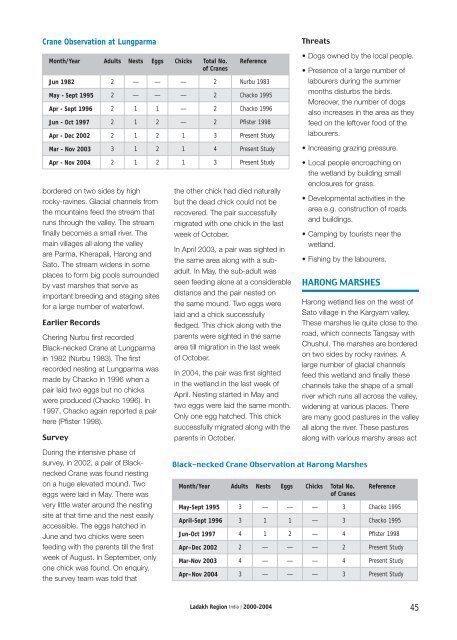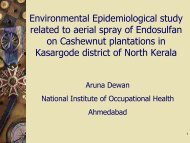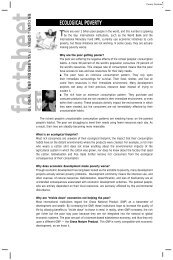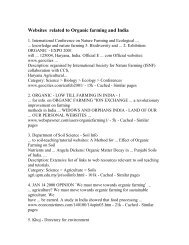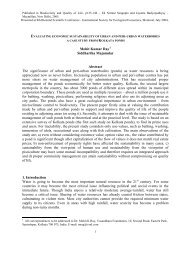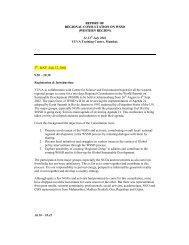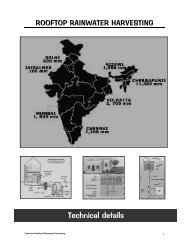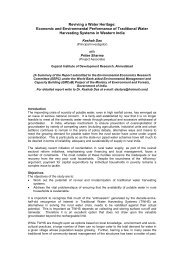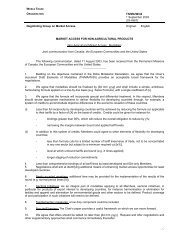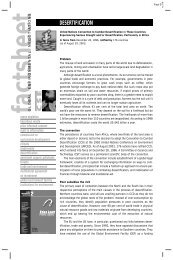Black-necked Crane - WWF-India
Black-necked Crane - WWF-India
Black-necked Crane - WWF-India
Create successful ePaper yourself
Turn your PDF publications into a flip-book with our unique Google optimized e-Paper software.
<strong>Crane</strong> Observation at Lungparma<br />
Month/Year Adults Nests Eggs Chicks Total No.<br />
of <strong>Crane</strong>s<br />
bordered on two sides by high<br />
rocky-ravines. Glacial channels from<br />
the mountains feed the stream that<br />
runs through the valley. The stream<br />
fi nally becomes a small river. The<br />
main villages all along the valley<br />
are Parma, Kherapali, Harong and<br />
Sato. The stream widens in some<br />
places to form big pools surrounded<br />
by vast marshes that serve as<br />
important breeding and staging sites<br />
for a large number of waterfowl.<br />
Earlier Records<br />
Chering Nurbu fi rst recorded<br />
<strong>Black</strong>-<strong>necked</strong> <strong>Crane</strong> at Lungparma<br />
in 1982 (Nurbu 1983). The fi rst<br />
recorded nesting at Lungparma was<br />
made by Chacko in 1996 when a<br />
pair laid two eggs but no chicks<br />
were produced (Chacko 1996). In<br />
1997, Chacko again reported a pair<br />
here (Pfi ster 1998).<br />
Survey<br />
Reference<br />
Jun 1982 2 — — — 2 Nurbu 1983<br />
May - Sept 1995 2 — — — 2 Chacko 1995<br />
Apr - Sept 1996 2 1 1 — 2 Chacko 1996<br />
Jun - Oct 1997 2 1 2 — 2 Pfister 1998<br />
Apr - Dec 2002 2 1 2 1 3 Present Study<br />
Mar - Nov 2003 3 1 2 1 4 Present Study<br />
Apr - Nov 2004 2 1 2 1 3 Present Study<br />
the other chick had died naturally<br />
but the dead chick could not be<br />
recovered. The pair successfully<br />
migrated with one chick in the last<br />
week of October.<br />
In April 2003, a pair was sighted in<br />
the same area along with a subadult.<br />
In May, the sub-adult was<br />
seen feeding alone at a considerable<br />
distance and the pair nested on<br />
the same mound. Two eggs were<br />
laid and a chick successfully<br />
fl edged. This chick along with the<br />
parents were sighted in the same<br />
area till migration in the last week<br />
of October.<br />
In 2004, the pair was fi rst sighted<br />
in the wetland in the last week of<br />
April. Nesting started in May and<br />
two eggs were laid the same month.<br />
Only one egg hatched. This chick<br />
successfully migrated along with the<br />
parents in October.<br />
Threats<br />
• Dogs owned by the local people.<br />
• Presence of a large number of<br />
labourers during the summer<br />
months disturbs the birds.<br />
Moreover, the number of dogs<br />
also increases in the area as they<br />
feed on the leftover food of the<br />
labourers.<br />
• Increasing grazing pressure.<br />
• Local people encroaching on<br />
the wetland by building small<br />
enclosures for grass.<br />
• Developmental activities in the<br />
area e.g. construction of roads<br />
and buildings.<br />
• Camping by tourists near the<br />
wetland.<br />
• Fishing by the labourers.<br />
HARONG MARSHES<br />
Harong wetland lies on the west of<br />
Sato village in the Kargyam valley.<br />
These marshes lie quite close to the<br />
road, which connects Tangsay with<br />
Chushul. The marshes are bordered<br />
on two sides by rocky ravines. A<br />
large number of glacial channels<br />
feed this wetland and fi nally these<br />
channels take the shape of a small<br />
river which runs all across the valley,<br />
widening at various places. There<br />
are many good pastures in the valley<br />
all along the river. These pastures<br />
along with various marshy areas act<br />
During the intensive phase of<br />
survey, in 2002, a pair of <strong>Black</strong><strong>necked</strong><br />
<strong>Crane</strong> was found nesting<br />
on a huge elevated mound. Two<br />
eggs were laid in May. There was<br />
very little water around the nesting<br />
site at that time and the nest easily<br />
accessible. The eggs hatched in<br />
June and two chicks were seen<br />
feeding with the parents till the fi rst<br />
week of August. In September, only<br />
one chick was found. On enquiry,<br />
the survey team was told that<br />
<strong>Black</strong>-<strong>necked</strong> <strong>Crane</strong> Observation at Harong Marshes<br />
Month/Year Adults Nests Eggs Chicks Total No.<br />
of <strong>Crane</strong>s<br />
Reference<br />
May-Sept 1995 3 — — — 3 Chacko 1995<br />
April-Sept 1996 3 1 1 — 3 Chacko 1995<br />
Jun-Oct 1997 4 1 2 — 4 Pfister 1998<br />
Apr–Dec 2002 2 — — — 2 Present Study<br />
Mar-Nov 2003 4 — — — 4 Present Study<br />
Apr–Nov 2004 3 — — — 3 Present Study<br />
Ladakh Region <strong>India</strong> | 2000-2004 45


